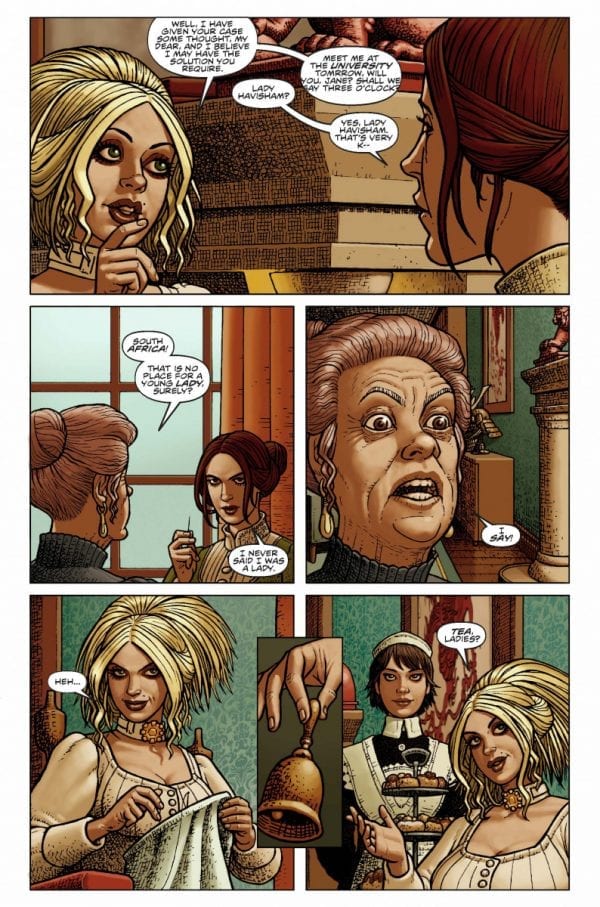In the spirit of The League of Extraordinary Gentlemen, Titan Comics new title Adler fuses a host of fictional and historical characters in an exciting adventure story. Set at the turn of the last century with an almost all female cast, creators Lavie Tidhar and Paul McCaffrey invite readers into a spectacular but dangerous world with a touch of the steampunk aesthetic.
Following the adventures of Irene Adler, as told by her new companion Jane (surname rhymes with ‘air’), the set up is pure Sherlock Holmes. But does the comic manager to escape these well known roots? Is there more on offer then a simple female Holmes and Watson story?

Telling the Tale
Lavie Tidhar is an awarding winning novelist, in fact he has been nominated or been the winner of an award every year in the last decade. He is also no stranger to mixing historical and fictional characters.
The story starts by introducing the reader to Jane and her time in the Boer War. This comic’s tone is set in that opening sequence. It has a sense of adventure, a pioneering spirit, but is also brutal when dealing with violence. It is also just as brutal to the characters, dispensing with extra’s with little fanfare but extreme violence.
Long before the titular character is introduced, Tidhar sets up the world where his characters live. This allows the reader to become immersed in the atmosphere before the plot begins. Each cast member is brought into Jane’s life naturally so that the reader meets them in the same circumstances as the character. Tidhar leads you through his version of London, pointing out people and places of interest as he goes.
This does mean that there are a few exchanges early on that have awkward dialogue. The conversation doesn’t flow as naturally as you would expect and reads like over rehearsed lines in a mediocre television drama. While these moments might give you a little insight into one of the characters it does little for the supporting cast. The stereotypes of steampunk fiction are harshly contrasted with the tropes of romantic prose.
However, this is a minor criticism of Adler as the majority of the dialogue sparks with life and brings the characters to life in a fun, exciting way. The personalities are drawn from the speech giving the leading ladies distinct individuality, which is refreshing. Tidhar has crafted a group of fully rounded characters, each with their own strengths and flaws.
This is especially exciting with an all female hero group. It is true that each character has a specific defining aspect but even within this first issue of Adler there are depths waiting to be explored. Tidhar has pushed his narrative beyond two dimensional characters representing a type and instead given the reader a team of characters for us to get to know.

Art and Design
Paul McCaffrey has a singular style that suits this type of modern adventure. His layouts and panel transitions underline the fast pace within the narrative and owe as much to television dramas like Sherlock than to traditional comics. There is also a startling sense of energy to the artwork. The characters leap from the page, and even drinks around a table doesn’t feel static in any way.
The design, especially with the leading women’s costumes, takes inspiration from the historical dress but then pushes it into fantastical realms. Elements of Steampunk filter through but there are also hints of other influences. It is sleek, and sexy, but most importantly everything fits with the characteristics of those wearing the clothes. For example, the eccentric Miss Havisham has attire that reflects her outgoing personality. She is like a Victorian version of Emma Frost.
McCaffrey’s coloring is also very detailed and bold. This fills the pages with a vast amount of information to take in, sometimes making pages seem busy. There is a lot going on and this can become distracting, especially if you want to take in as much as possible on the first read through. Once you have become accustomed to McCaffrey’s work, it becomes easier to read and by laying down his own colors, he is able to make the page entirely his.
Another slight drawback of McCaffrey’s highly detailed style is that it does, on occasion, leave Simon Bowland with very little room to play with on the lettering side. When he has short speeches or interplay’s of dialogue, Bowland is able to produce a brilliant sense of back and forth between characters. He picks up on the fact pace of the narrative and reflects this in his balloon placement. There are, unfortunately, panels where large pieces of text sit heavily in single balloons because there is simply no-where else to put them.
Bowland has a difficult job of deciding between bunching the speech into a single area or covering up McCaffrey’s great art work. It is a lose/lose situation for him but he makes up for it throughout the rest of the comic.

Conclusion
If you are looking for adventure and a large dollop of sass, then Adler will be right up your street. Drawing on the tradition of League of Extraordinary Gentlemen, Tidhar brings together an exciting mix of fictional characters, with a few hints at others let to come. He also creates a wonderful comradery between the women, filling the script with as much humour as there is action.
The links with Sherlock Holmes are somewhat integral to the plot but don’t actually require any real background knowledge. The story is self contained and easily accessible. The artwork is enchanting with beautiful design work. There is a definite style which could, potentially, put some readers off but is more likely to attract readers. Like Titan Comics previous comic, Anno Dracula, Adler is a fun and playful historical-ish adventure story.

